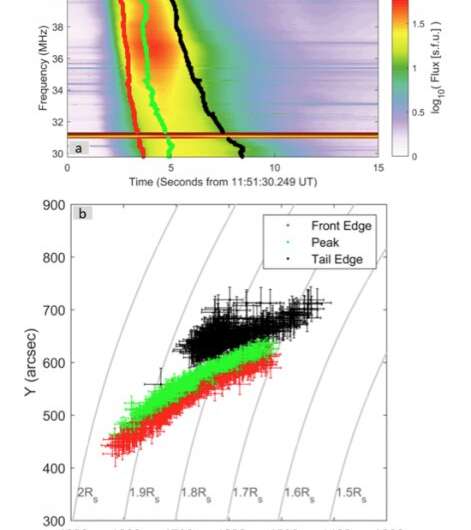Figure 1 – The dynamic spectrum of the type III radio burst and the source position of its front edge, the peak, and the tail edge. The red, green, and black colours represent the front edge, the peak, and the tail edge of the burst, respectively. Credit: Zhang et al ApJ (2019)
Type III solar radio bursts are generated by non-thermal electron beams propagating through the solar corona and interplanetary space. In dynamic spectra, the flux of solar type III radio bursts have a time profile of rising and decay phases at a given frequency, which has been actively studied since the 1970s.
There are several factors that may contribute to the observed duration of a type III radio burst: (1) The velocity dispersion of the electron beam exciter; (2) The fluctuation of background electron density; (3) The propagation effect due to wave scattering and refraction; (4) The intrinsic emission process of the radio wave. However, which one is the dominant factor is still an open question.
The LOw-Frequency Array (LOFAR) is an advanced radio antenna array with the capability of producing dynamic spectra and radio images at the same time with high resolution. Figure 1(a) shows the dynamic spectrum of a type III radio burst observed by LOFAR at 11:51 UT on 2015 May 6. It is a single, clear burst with a duration of about three seconds and is associated with a small limb flare.
With the LOFAR beam-formed mode, researchers can obtain the source position at different times and frequency channels within the Type III radio burst. The centroid source positions of the front edge, the peak, and the tail edge in the dynamic spectrum are shown in Figure 1(b). It was found that the source positions of the front edge, the peak and the tail edge split with each other spatially. This may indicate that they are generated by electron beams moving in different magnetic flux tubes in the corona. The radial speed of the electrons exciting the front edge, the peak, and the tail edge is 0.42 c, 0.25 c, and 0.16 c, respectively.
The contribution of the electron velocity difference to the observed duration can be estimated by statistical survey of the arrival time of the sources at a given height. The level of the coronal density fluctuation at a given height can be measured by a statistically survey of the wave frequency distribution of the sources observed at the same height, so that contribution of the corona density fluctuation to the duration can be estimated. And fortunately, the wave propagation effect can be evaluated by comparison with a few shorter-term bursts from the same region, which took place just at about 50 seconds before the type III burst.
The analysis yields that in the frequency range of 30–41 MHz, the electron velocity dispersion is the dominant factor that determines the time duration of type III radio bursts with long duration, while scattering may play an important role in the duration of short bursts.
More information: PeiJin Zhang et al. On the Source Position and Duration of a Solar Type III Radio Burst Observed by LOFAR, The Astrophysical Journal (2019). DOI: 10.3847/1538-4357/ab458f
Journal information: Astrophysical Journal
Provided by Community of European Solar Radio Astronomers
























